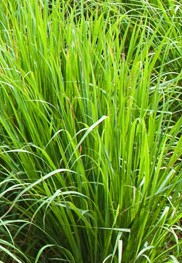 Lemon grass is an evergreen, clump-forming perennial native to southern India and Sri Lanka where it grows in dry stony areas. The bulbous lower leaf section of the plant is an important ingredient in Southeast Asian cooking with its a lemon flavor and tough chewy texture. The plant can easily be grown on a windowsill with bright light for culinary purposes but also makes an attractive garden plant. The linear arching leaves are light green and have very sharp edges. The flowers are inconspicuous and are rarely produced. Since the plants are tender, they are usually grown as annuals in the garden. Six inches stalks with their bulbous bases can be harvested before the first frost and frozen without leaves or roots for culinary use. Off sets can be over-wintered as houseplants and set out again in the spring after the last frost. Lemon grass is tolerant of drought, wet soil, and air pollution. Its tolerance of wet soil makes it a good choice for a rain garden and its rapid growth makes it a good edger in a border.
Lemon grass is an evergreen, clump-forming perennial native to southern India and Sri Lanka where it grows in dry stony areas. The bulbous lower leaf section of the plant is an important ingredient in Southeast Asian cooking with its a lemon flavor and tough chewy texture. The plant can easily be grown on a windowsill with bright light for culinary purposes but also makes an attractive garden plant. The linear arching leaves are light green and have very sharp edges. The flowers are inconspicuous and are rarely produced. Since the plants are tender, they are usually grown as annuals in the garden. Six inches stalks with their bulbous bases can be harvested before the first frost and frozen without leaves or roots for culinary use. Off sets can be over-wintered as houseplants and set out again in the spring after the last frost. Lemon grass is tolerant of drought, wet soil, and air pollution. Its tolerance of wet soil makes it a good choice for a rain garden and its rapid growth makes it a good edger in a border.
Type: Evergreen, perennial grass often grown as a houseplant or annual
Bloom: Inconspicuous and rare
Size: 2-4’ H x 2-3’ W
Light: Full sun to light shade
Soil: Prefers fertile, moist, well-drained soil but grows in both dry and wet soil.
Hardiness: Zones 9-11
Care: During the growing season, apply a balanced fertilizer monthly to in ground plants; half-strength balanced fertilizer every week to potted plants.
Pests and Diseases: None of significance; spider mites may be a problem when grown indoors.
Propagation: Seed (difficult to find); stalks bought in the grocery store can be rooted in water.
